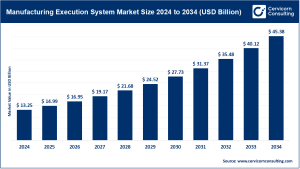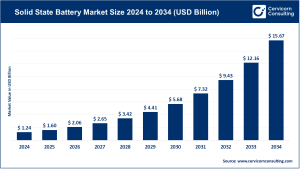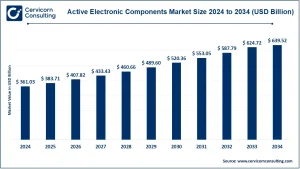Market Overview
The global Silicon Carbide (SiC) MOSFET market is estimated at approximately USD 2.34 billion in 2024 and is expected to expand to around USD 29.17 billion by 2034, registering a CAGR of 28.69% between 2025 and 2034. SiC MOSFETs are next-generation semiconductor devices that use silicon carbide rather than conventional silicon, providing higher efficiency, lower energy losses, and enhanced thermal and voltage performance. These devices are widely adopted across electric vehicles (EVs), renewable energy systems, industrial automation, aerospace, and other high-performance applications.
Key Market Trends
-
Electrification of Vehicles: SiC MOSFETs are increasingly integrated into EV inverters, motor drives, and chargers, reducing energy loss by up to 50%, improving battery performance, and enabling faster charging. By 2030, over 50% of new EV inverters are projected to adopt SiC MOSFET technology.
-
Renewable Energy Integration: SiC MOSFETs enhance solar inverters and wind turbines, achieving power conversion efficiencies above 98%, supporting high-voltage operations while minimizing energy losses.
-
Miniaturization and High Power Density: SiC-based power electronics enable devices that are up to 50% smaller than silicon-based equivalents, allowing more compact designs in industrial and consumer applications.
-
Advanced Wafer Technologies: The use of 150mm and 200mm wafer technologies has improved production efficiency, reliability, and performance, helping manufacturers differentiate their SiC MOSFET offerings.
-
High-Temperature Operation: SiC devices can function at temperatures exceeding 200°C, compared to 150°C for conventional silicon MOSFETs, making them suitable for extreme environmental and industrial conditions.
Market Drivers
-
Rising EV Adoption: Global demand for EVs is accelerating SiC MOSFET deployment in inverters, chargers, and motor drives, enhancing vehicle range and battery longevity.
-
Government Policies and Incentives: Regulations encouraging clean energy and carbon reduction are boosting SiC MOSFET adoption in automotive and industrial sectors.
-
Industrial Automation Expansion: The push for energy-efficient, high-speed industrial machinery increases the demand for high-performance SiC devices.
-
Technological Advancements: Ongoing R&D in SiC wafer production and device design reduces costs, improves reliability, and enables broader high-power application usage.
-
Renewable Energy Growth: Widespread adoption of solar and wind energy requires efficient power conversion, making SiC MOSFETs essential.
Quantitative Impact: EV applications reduce energy losses by approximately 50%, while SiC-powered solar inverters achieve >98% efficiency, driving strong adoption across these segments.
Impact of Trends and Drivers
-
Automotive Sector: SiC MOSFETs enable faster charging, higher efficiency, and more compact inverters, supporting next-generation EVs with extended range.
-
Industrial Automation: High-temperature tolerance and miniaturization facilitate reliable and safe motor drives and automation equipment.
-
Renewable Energy: Enhanced power conversion efficiency promotes large-scale solar and wind deployment with minimal energy wastage.
-
Regional Influence: Asia-Pacific leads the market with 33.4% revenue share in 2024, followed by Europe at 29.9%, driven by strong EV adoption and renewable energy initiatives.
Challenges & Opportunities
-
Challenges: High production costs of SiC MOSFETs and limited large-scale wafer availability could restrict market growth.
-
Opportunities: Advancements in wafer fabrication, strategic partnerships, and government incentives for clean energy adoption offer significant potential for market expansion.
Future Outlook
The SiC MOSFET market is poised for robust growth, driven by trends such as EV electrification, renewable energy expansion, miniaturization, and high-temperature operation. Technological innovation and supportive regulations will further cement SiC MOSFETs as a critical component in the global transition toward energy-efficient power electronics.


